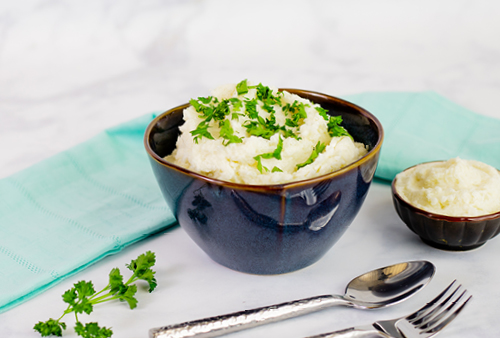Potassium Control Tips for a Healthy Life
Why is Potassium Control Important?
Potassium is a necessary nutrient that helps the heart and muscles function properly. However, too much potassium can be harmful to the body. For those with chronic kidney disease (CKD), potassium control is especially important. When CKD is present, especially advanced stages, the body has a more difficult time filtering out potassium adequately. As a result, potassium can go too high in the blood. High potassium can also occur from eating too many high potassium foods or taking medications or supplements high in potassium. Check with your doctor if you have questions about your medications or supplements. High potassium or hyperkalemia can cause muscle fatigue, tingling, numbness, nausea, weakness, abnormal heart rhythms and paralysis. Low potassium, or hypokalemia, can also be an issue. This can occur as a result from vomiting or diarrhea. Keeping potassium levels within the normal range can help keep the body healthier.
Normal Potassium Levels
Normal potassium levels are between 3.5-5.5 mEq/L. Potassium levels are checked according to your doctor or dietitian. Check with your renal dietitian or doctor if you have further questions about your potassium level.
Tips for Controlling Potassium:
Potassium is found in many foods, from dairy products and chocolate to nuts and beans. Following a low-potassium diet can be beneficial for those with CKD who have been prescribed a low-potassium diet. Potassium levels can be controlled by following these simple tips:
- Avoid salt substitutes – Regular table salt contains sodium and for those with CKD, too much sodium can be harmful to the body. However, many salt substitutes on the grocery shelves contain potassium chloride, which may make potassium levels rise in the body. To adhere to a low-sodium diet without adding unnecessary potassium, opt for low-sodium or salt-free seasonings, fresh herbs, or other spices to add flavor to your food.
- Follow a low-potassium diet – Many foods contain potassium, making it difficult to maintain a low-potassium diet. The list below has some higher potassium foods listed. Consult your dietitian to see how often and how much of these foods are safe for you to include.
- Read labels – Check the nutrition facts label for the potassium content of packaged foods. Many labels will list the amount of potassium in milligrams. The typical recommendation for a low-potassium diet is 2,000 milligrams per day. Be mindful of serving sizes and portions that you eat.
- Don’t miss a dialysis treatment – If you receive dialysis, it is important to attend all of your treatments so that potassium does not build up in your blood.
Following a Low-Potassium Diet
If recommended by a doctor and dietitian, avoiding or limiting high potassium foods can be beneficial to overall health. A high-potassium food typically contains about 250 mg or more of potassium per serving. When eating these high potassium foods, it is recommended to limit serving sizes to about 1/2 cup or 4 ounces or the amount recommended by your dietitian. Some of the most common high potassium foods are listed below.
| Fruit | Oranges, mango, starfruit, bananas, kiwi, guava, casaba, nectarines, papaya, cantaloupe, honeydew, prune juice |
| Vegetables | Potatoes, tomatoes, avocados, beets, beet greens, carrot juice, Swiss chard, bamboo shoots, winter squash, tomato juice, pumpkin, fresh water chestnuts |
| Dairy Products and Milk Alternatives | Dairy milk, yogurt, ice cream, soy milk, cheese |
| Other | Potato chips, French fries, hash browns, chocolate, beans, salt substitutes |
Lowering Potassium in Potatoes
Potatoes are both delicious and easy to cook. However, they have a high potassium content. One average sized whole baked potato contains about 900 milligrams, which is almost half of the daily recommended amount of potassium on a kidney-friendly diet. Potatoes can still be enjoyed by those following a kidney friendly diet with some helpful tips. Double boiling and leaching potatoes both can reduce the potassium content of this high potassium vegetable. A 1/2-cup serving can still contain 100 to 200 mg of potassium, so limit portion sizes accordingly.
| Leaching Method | Remove skin, cut into small pieces or grate thinly. Then soak in large bowl of water at room temperature for at least 4 hours. |
| Double Boiling Method | Remove skin, cut into small pieces or grate thinly. Then boil pieces in a large pot of water for at least 10 minutes. Drain and add fresh water. Cook until done. |
Lower Potassium Recipes
Use these tips and tricks for keeping your potassium within the normal range. Opt for low-potassium foods when planning your meals and try to avoid high potassium foods. Try these low-potassium recipes as flavorful alternatives.

- Almost Mashed Potatoes
- Garlic Mashed Potatoes
- Slow Cooker Pot Roast with Low Potassium Potatoes
- Sweet Potato Pie
- Picnic Potato Salad
References
- https://www.davita.com/diet-nutrition/articles/basics/potassium-and-chronic-kidney-disease
- https://www.kidney.org/content/six-steps-control-high-potassium
- https://www.mayoclinic.org/symptoms/hyperkalemia/basics/definition/sym-20050776
- https://www.davita.com/diet-nutrition/articles/advice/shake-the-salt-habit-when-you-have-kidney-disease
- https://blogs.davita.com/kidney-diet-tips/controlling-high-potassium-in-chronic-kidney-disease/
- https://www.davita.com/treatment-services/dialysis/in-center-hemodialysis/dietitians-at-the-dialysis-center
- https://www.mayoclinic.org/symptoms/low-potassium/basics/definition/sym-20050632
- https://www.davita.com/diet-nutrition/articles/basics/lowering-potassium-in-potatoes
Additional Kidney Diet Resources
Visit DaVita.com and explore these diet and nutrition resources:
DaVita Kidney-Friendly Recipes
This article is for informational purposes only and is not a substitute for medical advice or treatment. Consult your physician and dietitian regarding your specific diagnosis, treatment, diet and health questions.

Recent Comments